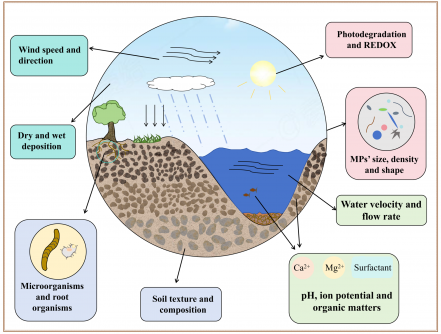Science
Researchers Uncover Key Factors in Microplastics Migration

A comprehensive review by researchers from the Chongqing Institute of Green and Intelligent Technology and the Chinese Academy of Sciences has shed light on the complex factors that influence the migration and distribution of microplastics (MPs) in the environment. Published in the journal Frontiers of Environmental Science & Engineering in 2025, the study highlights the pervasive presence of microplastics as emerging pollutants, impacting aquatic, terrestrial, and atmospheric systems.
Microplastics, defined as plastic particles with diameters less than 5 mm, are classified based on their chemical composition, particle size, and origin. These pollutants pose significant risks to ecosystems and human health through processes such as bioaccumulation and composite pollution. Despite the growing awareness of their environmental impact, the mechanisms that drive their movement and fate across different media remain largely unresolved.
The research team aimed to clarify these complexities by synthesizing current insights into the multifaceted factors that govern MP behavior. They systematically summarized key drivers that affect the migration of microplastics, including intrinsic properties of the particles—such as size, shape, and aging state—and various environmental factors. These environmental influences encompass physical aspects like hydrological parameters, soil texture, meteorological conditions, lighting, and temperature, as well as chemical factors including pH, inorganic ions, and organic matter. Additionally, biological factors such as microorganisms and root organisms play a crucial role in the distribution of microplastics.
Understanding Microplastics Migration
The intricate interplay of these factors determines the transport pathways, retention hotspots, and the long-term ecological trajectories of microplastics. The review establishes a unified framework for understanding the environmental interactions of these pollutants, emphasizing the need for a comprehensive approach to address their impact.
In addition to outlining these factors, the researchers proposed several regulatory strategies aimed at mitigating the effects of microplastics. Recommended measures include source control, such as banning primary microplastics and developing biodegradable alternatives. The study also advocates for process interruption techniques, including the use of constructed wetlands, biochar, and plant shelterbelts to reduce the environmental presence of microplastics.
This research provides critical insights that can guide future policies and practices aimed at managing microplastics and minimizing their detrimental effects on ecosystems and human health. For a more detailed exploration of the findings, the full paper is accessible at: https://doi.org/10.1007/s11783-025-2062-z.
-

 Lifestyle4 months ago
Lifestyle4 months agoLibraries Challenge Rising E-Book Costs Amid Growing Demand
-

 Sports4 months ago
Sports4 months agoTyreek Hill Responds to Tua Tagovailoa’s Comments on Team Dynamics
-

 Sports4 months ago
Sports4 months agoLiverpool Secures Agreement to Sign Young Striker Will Wright
-

 Lifestyle4 months ago
Lifestyle4 months agoSave Your Split Tomatoes: Expert Tips for Gardeners
-

 Lifestyle4 months ago
Lifestyle4 months agoPrincess Beatrice’s Daughter Athena Joins Siblings at London Parade
-

 World4 months ago
World4 months agoWinter Storms Lash New South Wales with Snow, Flood Risks
-

 Science3 months ago
Science3 months agoSan Francisco Hosts Unique Contest to Identify “Performative Males”
-

 Science4 months ago
Science4 months agoTrump Administration Moves to Repeal Key Climate Regulation
-

 Business4 months ago
Business4 months agoSoFi Technologies Shares Slip 2% Following Insider Stock Sale
-

 Science4 months ago
Science4 months agoNew Tool Reveals Link Between Horse Coat Condition and Parasites
-

 Sports4 months ago
Sports4 months agoElon Musk Sculpture Travels From Utah to Yosemite National Park
-

 Science4 months ago
Science4 months agoNew Study Confirms Humans Transported Stonehenge Bluestones









